Global Prospective on Social Determinants of Health in Australia
VerifiedAdded on 2021/06/18
|15
|4278
|86
Essay
AI Summary
This essay delves into the critical role of employment conditions as a social determinant of health, focusing on the Australian context and families living below the poverty line. It explores the adverse effects of poor working conditions, unemployment, and low wages on the physical, mental, and social well-being of these vulnerable populations. The essay highlights how factors such as job security, work-life balance, and access to healthcare are significantly impacted by employment status. It also examines the Australian government's efforts to address these issues and the need for improved social and economic factors to enhance health outcomes. The paper further discusses how employment conditions can either enhance or diminish health, emphasizing the need for health organizations to move upstream to address the social and economic factors that influence the health of families and the importance of creating ideal employment conditions that promote health and well-being. The essay concludes by discussing the impacts of employment conditions on impoverished workers, stressing the need for better working conditions and improved health equity among low-income populations.
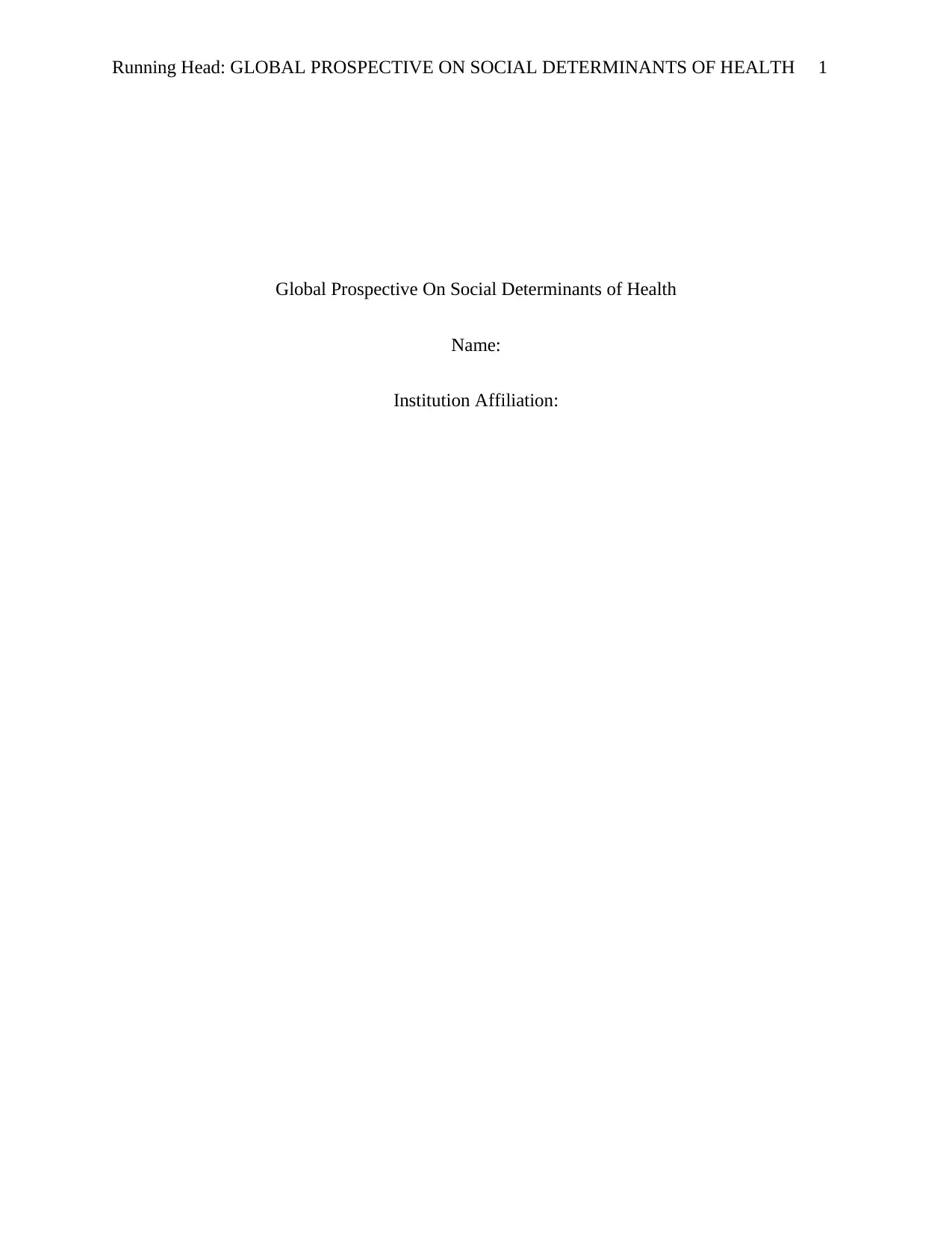
Running Head: GLOBAL PROSPECTIVE ON SOCIAL DETERMINANTS OF HEALTH 1
Global Prospective On Social Determinants of Health
Name:
Institution Affiliation:
Global Prospective On Social Determinants of Health
Name:
Institution Affiliation:
Paraphrase This Document
Need a fresh take? Get an instant paraphrase of this document with our AI Paraphraser
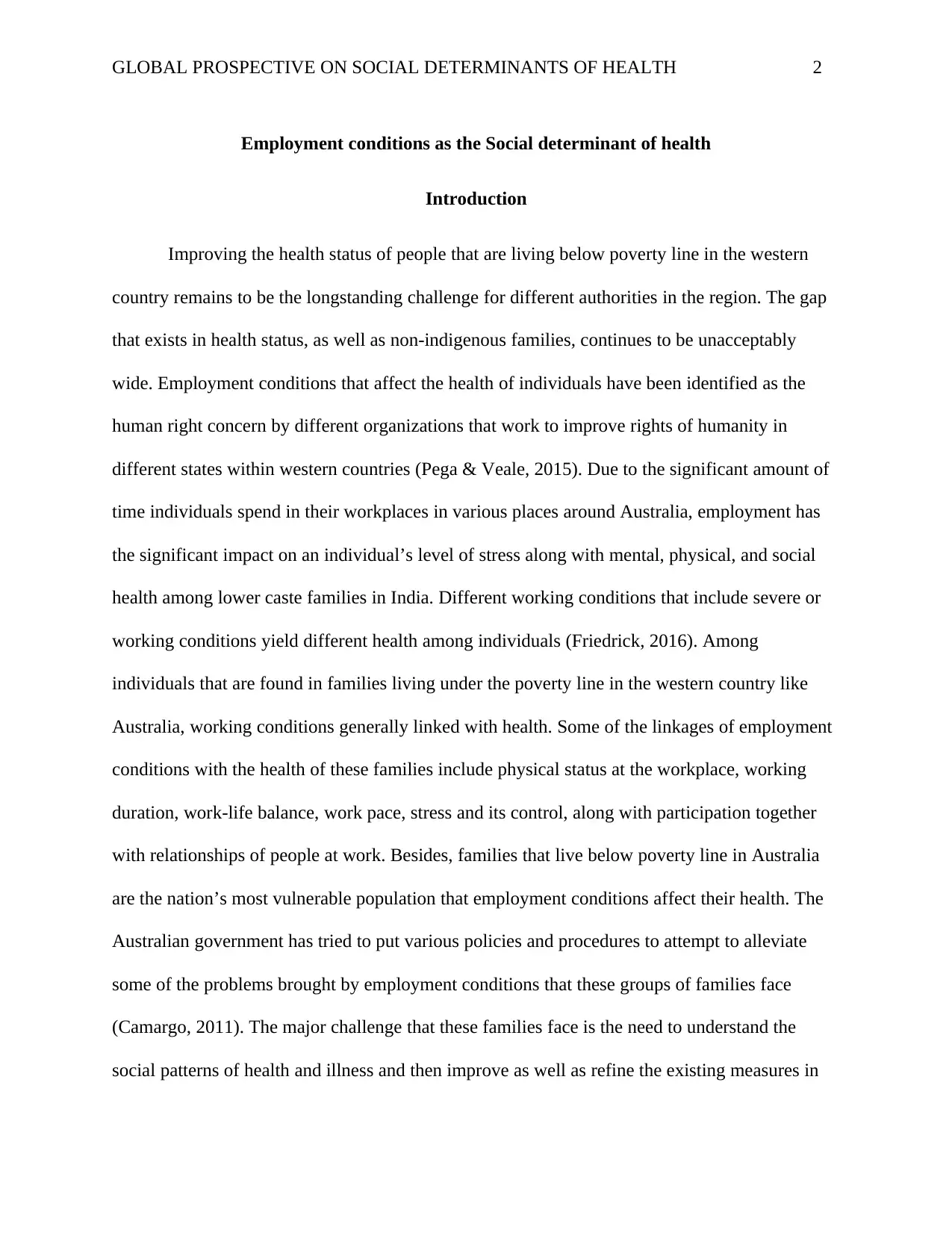
GLOBAL PROSPECTIVE ON SOCIAL DETERMINANTS OF HEALTH 2
Employment conditions as the Social determinant of health
Introduction
Improving the health status of people that are living below poverty line in the western
country remains to be the longstanding challenge for different authorities in the region. The gap
that exists in health status, as well as non-indigenous families, continues to be unacceptably
wide. Employment conditions that affect the health of individuals have been identified as the
human right concern by different organizations that work to improve rights of humanity in
different states within western countries (Pega & Veale, 2015). Due to the significant amount of
time individuals spend in their workplaces in various places around Australia, employment has
the significant impact on an individual’s level of stress along with mental, physical, and social
health among lower caste families in India. Different working conditions that include severe or
working conditions yield different health among individuals (Friedrick, 2016). Among
individuals that are found in families living under the poverty line in the western country like
Australia, working conditions generally linked with health. Some of the linkages of employment
conditions with the health of these families include physical status at the workplace, working
duration, work-life balance, work pace, stress and its control, along with participation together
with relationships of people at work. Besides, families that live below poverty line in Australia
are the nation’s most vulnerable population that employment conditions affect their health. The
Australian government has tried to put various policies and procedures to attempt to alleviate
some of the problems brought by employment conditions that these groups of families face
(Camargo, 2011). The major challenge that these families face is the need to understand the
social patterns of health and illness and then improve as well as refine the existing measures in
Employment conditions as the Social determinant of health
Introduction
Improving the health status of people that are living below poverty line in the western
country remains to be the longstanding challenge for different authorities in the region. The gap
that exists in health status, as well as non-indigenous families, continues to be unacceptably
wide. Employment conditions that affect the health of individuals have been identified as the
human right concern by different organizations that work to improve rights of humanity in
different states within western countries (Pega & Veale, 2015). Due to the significant amount of
time individuals spend in their workplaces in various places around Australia, employment has
the significant impact on an individual’s level of stress along with mental, physical, and social
health among lower caste families in India. Different working conditions that include severe or
working conditions yield different health among individuals (Friedrick, 2016). Among
individuals that are found in families living under the poverty line in the western country like
Australia, working conditions generally linked with health. Some of the linkages of employment
conditions with the health of these families include physical status at the workplace, working
duration, work-life balance, work pace, stress and its control, along with participation together
with relationships of people at work. Besides, families that live below poverty line in Australia
are the nation’s most vulnerable population that employment conditions affect their health. The
Australian government has tried to put various policies and procedures to attempt to alleviate
some of the problems brought by employment conditions that these groups of families face
(Camargo, 2011). The major challenge that these families face is the need to understand the
social patterns of health and illness and then improve as well as refine the existing measures in
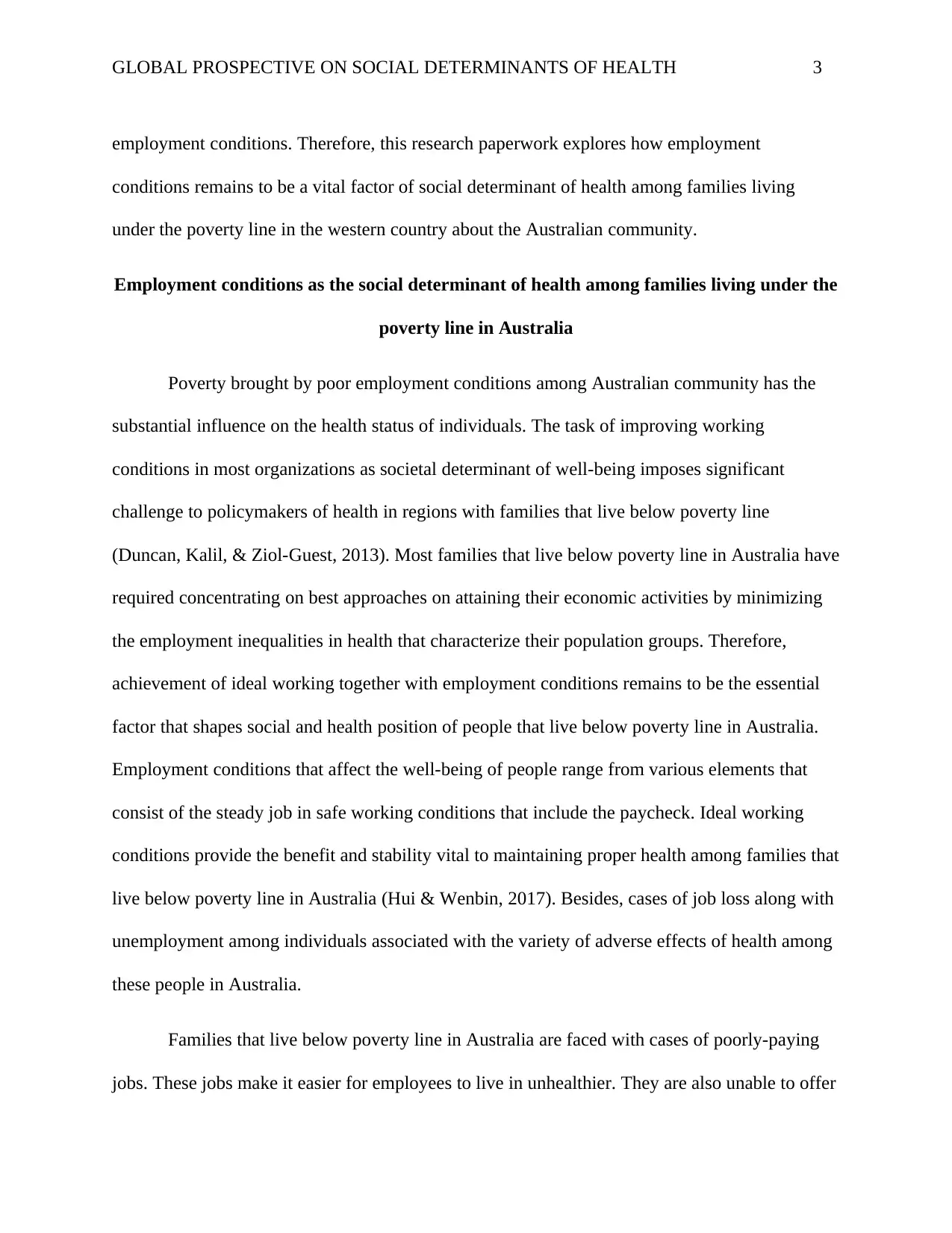
GLOBAL PROSPECTIVE ON SOCIAL DETERMINANTS OF HEALTH 3
employment conditions. Therefore, this research paperwork explores how employment
conditions remains to be a vital factor of social determinant of health among families living
under the poverty line in the western country about the Australian community.
Employment conditions as the social determinant of health among families living under the
poverty line in Australia
Poverty brought by poor employment conditions among Australian community has the
substantial influence on the health status of individuals. The task of improving working
conditions in most organizations as societal determinant of well-being imposes significant
challenge to policymakers of health in regions with families that live below poverty line
(Duncan, Kalil, & Ziol-Guest, 2013). Most families that live below poverty line in Australia have
required concentrating on best approaches on attaining their economic activities by minimizing
the employment inequalities in health that characterize their population groups. Therefore,
achievement of ideal working together with employment conditions remains to be the essential
factor that shapes social and health position of people that live below poverty line in Australia.
Employment conditions that affect the well-being of people range from various elements that
consist of the steady job in safe working conditions that include the paycheck. Ideal working
conditions provide the benefit and stability vital to maintaining proper health among families that
live below poverty line in Australia (Hui & Wenbin, 2017). Besides, cases of job loss along with
unemployment among individuals associated with the variety of adverse effects of health among
these people in Australia.
Families that live below poverty line in Australia are faced with cases of poorly-paying
jobs. These jobs make it easier for employees to live in unhealthier. They are also unable to offer
employment conditions. Therefore, this research paperwork explores how employment
conditions remains to be a vital factor of social determinant of health among families living
under the poverty line in the western country about the Australian community.
Employment conditions as the social determinant of health among families living under the
poverty line in Australia
Poverty brought by poor employment conditions among Australian community has the
substantial influence on the health status of individuals. The task of improving working
conditions in most organizations as societal determinant of well-being imposes significant
challenge to policymakers of health in regions with families that live below poverty line
(Duncan, Kalil, & Ziol-Guest, 2013). Most families that live below poverty line in Australia have
required concentrating on best approaches on attaining their economic activities by minimizing
the employment inequalities in health that characterize their population groups. Therefore,
achievement of ideal working together with employment conditions remains to be the essential
factor that shapes social and health position of people that live below poverty line in Australia.
Employment conditions that affect the well-being of people range from various elements that
consist of the steady job in safe working conditions that include the paycheck. Ideal working
conditions provide the benefit and stability vital to maintaining proper health among families that
live below poverty line in Australia (Hui & Wenbin, 2017). Besides, cases of job loss along with
unemployment among individuals associated with the variety of adverse effects of health among
these people in Australia.
Families that live below poverty line in Australia are faced with cases of poorly-paying
jobs. These jobs make it easier for employees to live in unhealthier. They are also unable to offer
⊘ This is a preview!⊘
Do you want full access?
Subscribe today to unlock all pages.

Trusted by 1+ million students worldwide
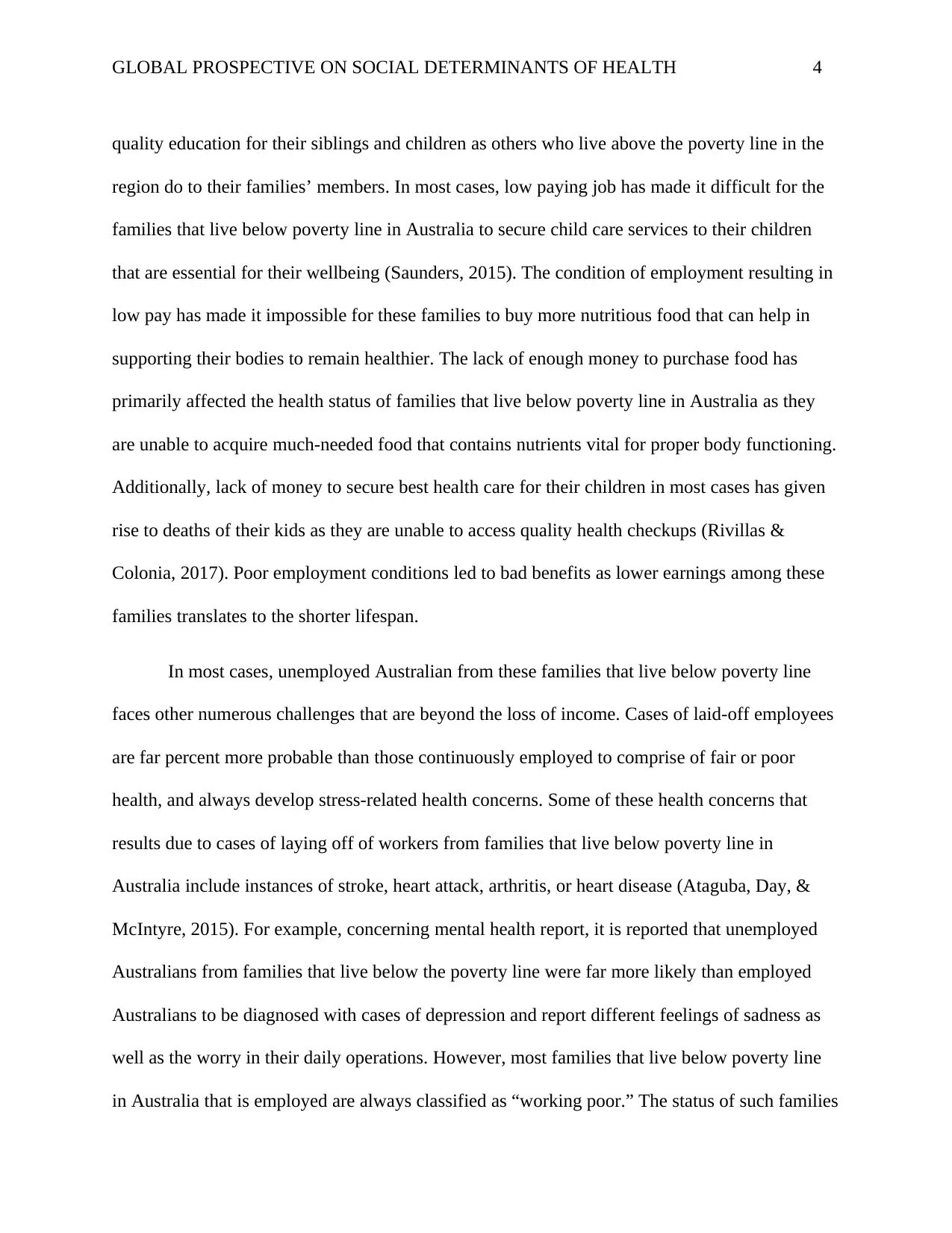
GLOBAL PROSPECTIVE ON SOCIAL DETERMINANTS OF HEALTH 4
quality education for their siblings and children as others who live above the poverty line in the
region do to their families’ members. In most cases, low paying job has made it difficult for the
families that live below poverty line in Australia to secure child care services to their children
that are essential for their wellbeing (Saunders, 2015). The condition of employment resulting in
low pay has made it impossible for these families to buy more nutritious food that can help in
supporting their bodies to remain healthier. The lack of enough money to purchase food has
primarily affected the health status of families that live below poverty line in Australia as they
are unable to acquire much-needed food that contains nutrients vital for proper body functioning.
Additionally, lack of money to secure best health care for their children in most cases has given
rise to deaths of their kids as they are unable to access quality health checkups (Rivillas &
Colonia, 2017). Poor employment conditions led to bad benefits as lower earnings among these
families translates to the shorter lifespan.
In most cases, unemployed Australian from these families that live below poverty line
faces other numerous challenges that are beyond the loss of income. Cases of laid-off employees
are far percent more probable than those continuously employed to comprise of fair or poor
health, and always develop stress-related health concerns. Some of these health concerns that
results due to cases of laying off of workers from families that live below poverty line in
Australia include instances of stroke, heart attack, arthritis, or heart disease (Ataguba, Day, &
McIntyre, 2015). For example, concerning mental health report, it is reported that unemployed
Australians from families that live below the poverty line were far more likely than employed
Australians to be diagnosed with cases of depression and report different feelings of sadness as
well as the worry in their daily operations. However, most families that live below poverty line
in Australia that is employed are always classified as “working poor.” The status of such families
quality education for their siblings and children as others who live above the poverty line in the
region do to their families’ members. In most cases, low paying job has made it difficult for the
families that live below poverty line in Australia to secure child care services to their children
that are essential for their wellbeing (Saunders, 2015). The condition of employment resulting in
low pay has made it impossible for these families to buy more nutritious food that can help in
supporting their bodies to remain healthier. The lack of enough money to purchase food has
primarily affected the health status of families that live below poverty line in Australia as they
are unable to acquire much-needed food that contains nutrients vital for proper body functioning.
Additionally, lack of money to secure best health care for their children in most cases has given
rise to deaths of their kids as they are unable to access quality health checkups (Rivillas &
Colonia, 2017). Poor employment conditions led to bad benefits as lower earnings among these
families translates to the shorter lifespan.
In most cases, unemployed Australian from these families that live below poverty line
faces other numerous challenges that are beyond the loss of income. Cases of laid-off employees
are far percent more probable than those continuously employed to comprise of fair or poor
health, and always develop stress-related health concerns. Some of these health concerns that
results due to cases of laying off of workers from families that live below poverty line in
Australia include instances of stroke, heart attack, arthritis, or heart disease (Ataguba, Day, &
McIntyre, 2015). For example, concerning mental health report, it is reported that unemployed
Australians from families that live below the poverty line were far more likely than employed
Australians to be diagnosed with cases of depression and report different feelings of sadness as
well as the worry in their daily operations. However, most families that live below poverty line
in Australia that is employed are always classified as “working poor.” The status of such families
Paraphrase This Document
Need a fresh take? Get an instant paraphrase of this document with our AI Paraphraser
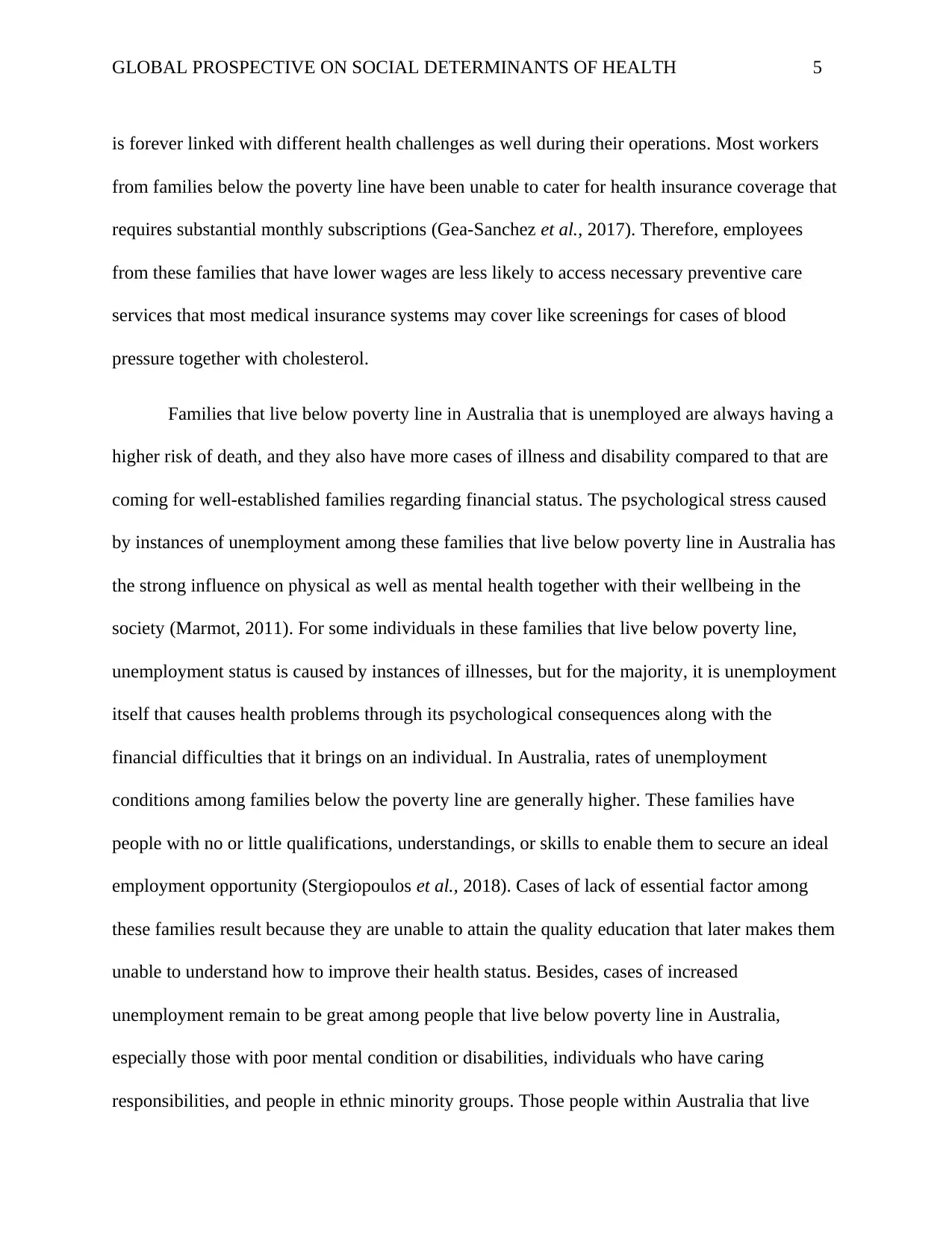
GLOBAL PROSPECTIVE ON SOCIAL DETERMINANTS OF HEALTH 5
is forever linked with different health challenges as well during their operations. Most workers
from families below the poverty line have been unable to cater for health insurance coverage that
requires substantial monthly subscriptions (Gea-Sanchez et al., 2017). Therefore, employees
from these families that have lower wages are less likely to access necessary preventive care
services that most medical insurance systems may cover like screenings for cases of blood
pressure together with cholesterol.
Families that live below poverty line in Australia that is unemployed are always having a
higher risk of death, and they also have more cases of illness and disability compared to that are
coming for well-established families regarding financial status. The psychological stress caused
by instances of unemployment among these families that live below poverty line in Australia has
the strong influence on physical as well as mental health together with their wellbeing in the
society (Marmot, 2011). For some individuals in these families that live below poverty line,
unemployment status is caused by instances of illnesses, but for the majority, it is unemployment
itself that causes health problems through its psychological consequences along with the
financial difficulties that it brings on an individual. In Australia, rates of unemployment
conditions among families below the poverty line are generally higher. These families have
people with no or little qualifications, understandings, or skills to enable them to secure an ideal
employment opportunity (Stergiopoulos et al., 2018). Cases of lack of essential factor among
these families result because they are unable to attain the quality education that later makes them
unable to understand how to improve their health status. Besides, cases of increased
unemployment remain to be great among people that live below poverty line in Australia,
especially those with poor mental condition or disabilities, individuals who have caring
responsibilities, and people in ethnic minority groups. Those people within Australia that live
is forever linked with different health challenges as well during their operations. Most workers
from families below the poverty line have been unable to cater for health insurance coverage that
requires substantial monthly subscriptions (Gea-Sanchez et al., 2017). Therefore, employees
from these families that have lower wages are less likely to access necessary preventive care
services that most medical insurance systems may cover like screenings for cases of blood
pressure together with cholesterol.
Families that live below poverty line in Australia that is unemployed are always having a
higher risk of death, and they also have more cases of illness and disability compared to that are
coming for well-established families regarding financial status. The psychological stress caused
by instances of unemployment among these families that live below poverty line in Australia has
the strong influence on physical as well as mental health together with their wellbeing in the
society (Marmot, 2011). For some individuals in these families that live below poverty line,
unemployment status is caused by instances of illnesses, but for the majority, it is unemployment
itself that causes health problems through its psychological consequences along with the
financial difficulties that it brings on an individual. In Australia, rates of unemployment
conditions among families below the poverty line are generally higher. These families have
people with no or little qualifications, understandings, or skills to enable them to secure an ideal
employment opportunity (Stergiopoulos et al., 2018). Cases of lack of essential factor among
these families result because they are unable to attain the quality education that later makes them
unable to understand how to improve their health status. Besides, cases of increased
unemployment remain to be great among people that live below poverty line in Australia,
especially those with poor mental condition or disabilities, individuals who have caring
responsibilities, and people in ethnic minority groups. Those people within Australia that live
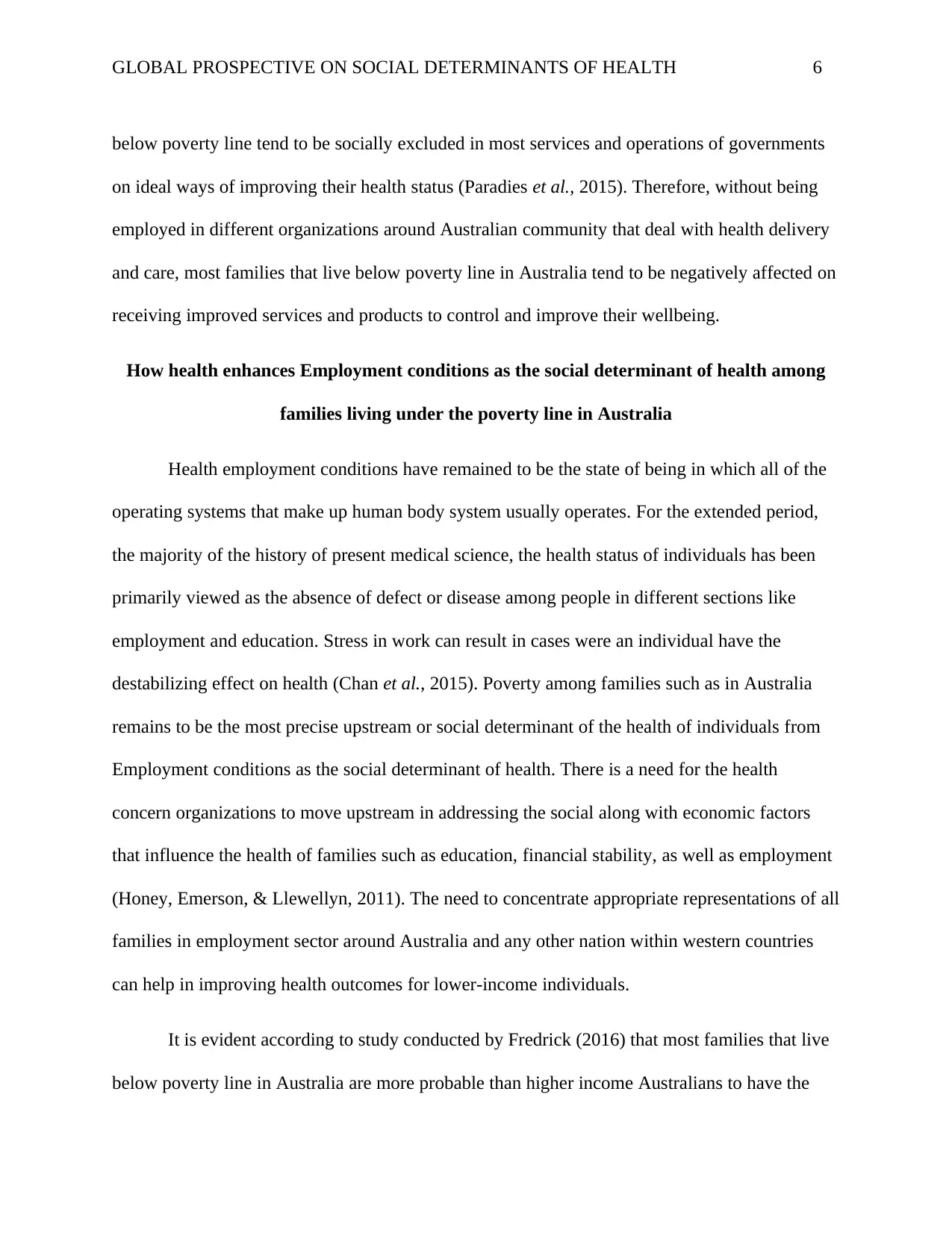
GLOBAL PROSPECTIVE ON SOCIAL DETERMINANTS OF HEALTH 6
below poverty line tend to be socially excluded in most services and operations of governments
on ideal ways of improving their health status (Paradies et al., 2015). Therefore, without being
employed in different organizations around Australian community that deal with health delivery
and care, most families that live below poverty line in Australia tend to be negatively affected on
receiving improved services and products to control and improve their wellbeing.
How health enhances Employment conditions as the social determinant of health among
families living under the poverty line in Australia
Health employment conditions have remained to be the state of being in which all of the
operating systems that make up human body system usually operates. For the extended period,
the majority of the history of present medical science, the health status of individuals has been
primarily viewed as the absence of defect or disease among people in different sections like
employment and education. Stress in work can result in cases were an individual have the
destabilizing effect on health (Chan et al., 2015). Poverty among families such as in Australia
remains to be the most precise upstream or social determinant of the health of individuals from
Employment conditions as the social determinant of health. There is a need for the health
concern organizations to move upstream in addressing the social along with economic factors
that influence the health of families such as education, financial stability, as well as employment
(Honey, Emerson, & Llewellyn, 2011). The need to concentrate appropriate representations of all
families in employment sector around Australia and any other nation within western countries
can help in improving health outcomes for lower-income individuals.
It is evident according to study conducted by Fredrick (2016) that most families that live
below poverty line in Australia are more probable than higher income Australians to have the
below poverty line tend to be socially excluded in most services and operations of governments
on ideal ways of improving their health status (Paradies et al., 2015). Therefore, without being
employed in different organizations around Australian community that deal with health delivery
and care, most families that live below poverty line in Australia tend to be negatively affected on
receiving improved services and products to control and improve their wellbeing.
How health enhances Employment conditions as the social determinant of health among
families living under the poverty line in Australia
Health employment conditions have remained to be the state of being in which all of the
operating systems that make up human body system usually operates. For the extended period,
the majority of the history of present medical science, the health status of individuals has been
primarily viewed as the absence of defect or disease among people in different sections like
employment and education. Stress in work can result in cases were an individual have the
destabilizing effect on health (Chan et al., 2015). Poverty among families such as in Australia
remains to be the most precise upstream or social determinant of the health of individuals from
Employment conditions as the social determinant of health. There is a need for the health
concern organizations to move upstream in addressing the social along with economic factors
that influence the health of families such as education, financial stability, as well as employment
(Honey, Emerson, & Llewellyn, 2011). The need to concentrate appropriate representations of all
families in employment sector around Australia and any other nation within western countries
can help in improving health outcomes for lower-income individuals.
It is evident according to study conducted by Fredrick (2016) that most families that live
below poverty line in Australia are more probable than higher income Australians to have the
⊘ This is a preview!⊘
Do you want full access?
Subscribe today to unlock all pages.

Trusted by 1+ million students worldwide
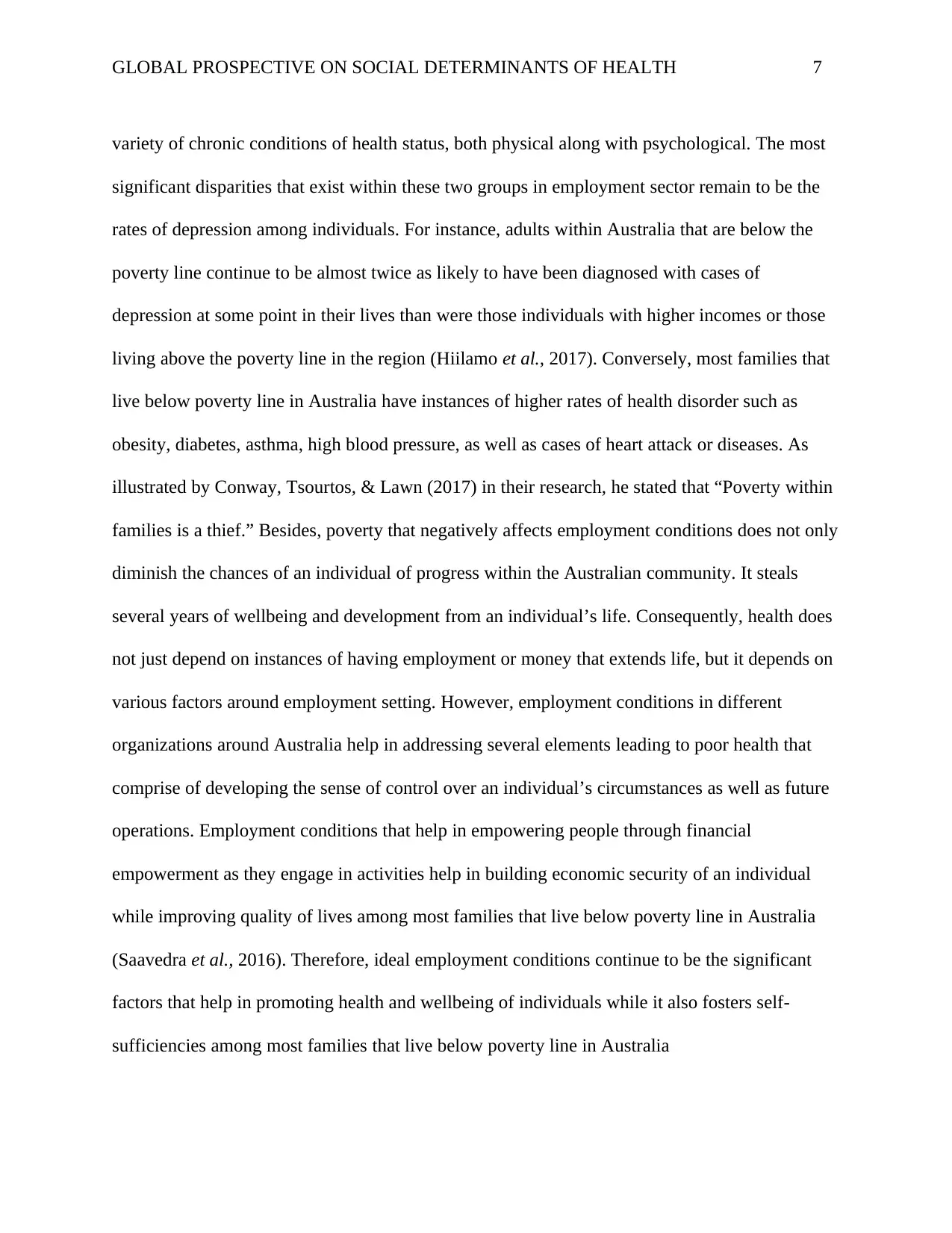
GLOBAL PROSPECTIVE ON SOCIAL DETERMINANTS OF HEALTH 7
variety of chronic conditions of health status, both physical along with psychological. The most
significant disparities that exist within these two groups in employment sector remain to be the
rates of depression among individuals. For instance, adults within Australia that are below the
poverty line continue to be almost twice as likely to have been diagnosed with cases of
depression at some point in their lives than were those individuals with higher incomes or those
living above the poverty line in the region (Hiilamo et al., 2017). Conversely, most families that
live below poverty line in Australia have instances of higher rates of health disorder such as
obesity, diabetes, asthma, high blood pressure, as well as cases of heart attack or diseases. As
illustrated by Conway, Tsourtos, & Lawn (2017) in their research, he stated that “Poverty within
families is a thief.” Besides, poverty that negatively affects employment conditions does not only
diminish the chances of an individual of progress within the Australian community. It steals
several years of wellbeing and development from an individual’s life. Consequently, health does
not just depend on instances of having employment or money that extends life, but it depends on
various factors around employment setting. However, employment conditions in different
organizations around Australia help in addressing several elements leading to poor health that
comprise of developing the sense of control over an individual’s circumstances as well as future
operations. Employment conditions that help in empowering people through financial
empowerment as they engage in activities help in building economic security of an individual
while improving quality of lives among most families that live below poverty line in Australia
(Saavedra et al., 2016). Therefore, ideal employment conditions continue to be the significant
factors that help in promoting health and wellbeing of individuals while it also fosters self-
sufficiencies among most families that live below poverty line in Australia
variety of chronic conditions of health status, both physical along with psychological. The most
significant disparities that exist within these two groups in employment sector remain to be the
rates of depression among individuals. For instance, adults within Australia that are below the
poverty line continue to be almost twice as likely to have been diagnosed with cases of
depression at some point in their lives than were those individuals with higher incomes or those
living above the poverty line in the region (Hiilamo et al., 2017). Conversely, most families that
live below poverty line in Australia have instances of higher rates of health disorder such as
obesity, diabetes, asthma, high blood pressure, as well as cases of heart attack or diseases. As
illustrated by Conway, Tsourtos, & Lawn (2017) in their research, he stated that “Poverty within
families is a thief.” Besides, poverty that negatively affects employment conditions does not only
diminish the chances of an individual of progress within the Australian community. It steals
several years of wellbeing and development from an individual’s life. Consequently, health does
not just depend on instances of having employment or money that extends life, but it depends on
various factors around employment setting. However, employment conditions in different
organizations around Australia help in addressing several elements leading to poor health that
comprise of developing the sense of control over an individual’s circumstances as well as future
operations. Employment conditions that help in empowering people through financial
empowerment as they engage in activities help in building economic security of an individual
while improving quality of lives among most families that live below poverty line in Australia
(Saavedra et al., 2016). Therefore, ideal employment conditions continue to be the significant
factors that help in promoting health and wellbeing of individuals while it also fosters self-
sufficiencies among most families that live below poverty line in Australia
Paraphrase This Document
Need a fresh take? Get an instant paraphrase of this document with our AI Paraphraser
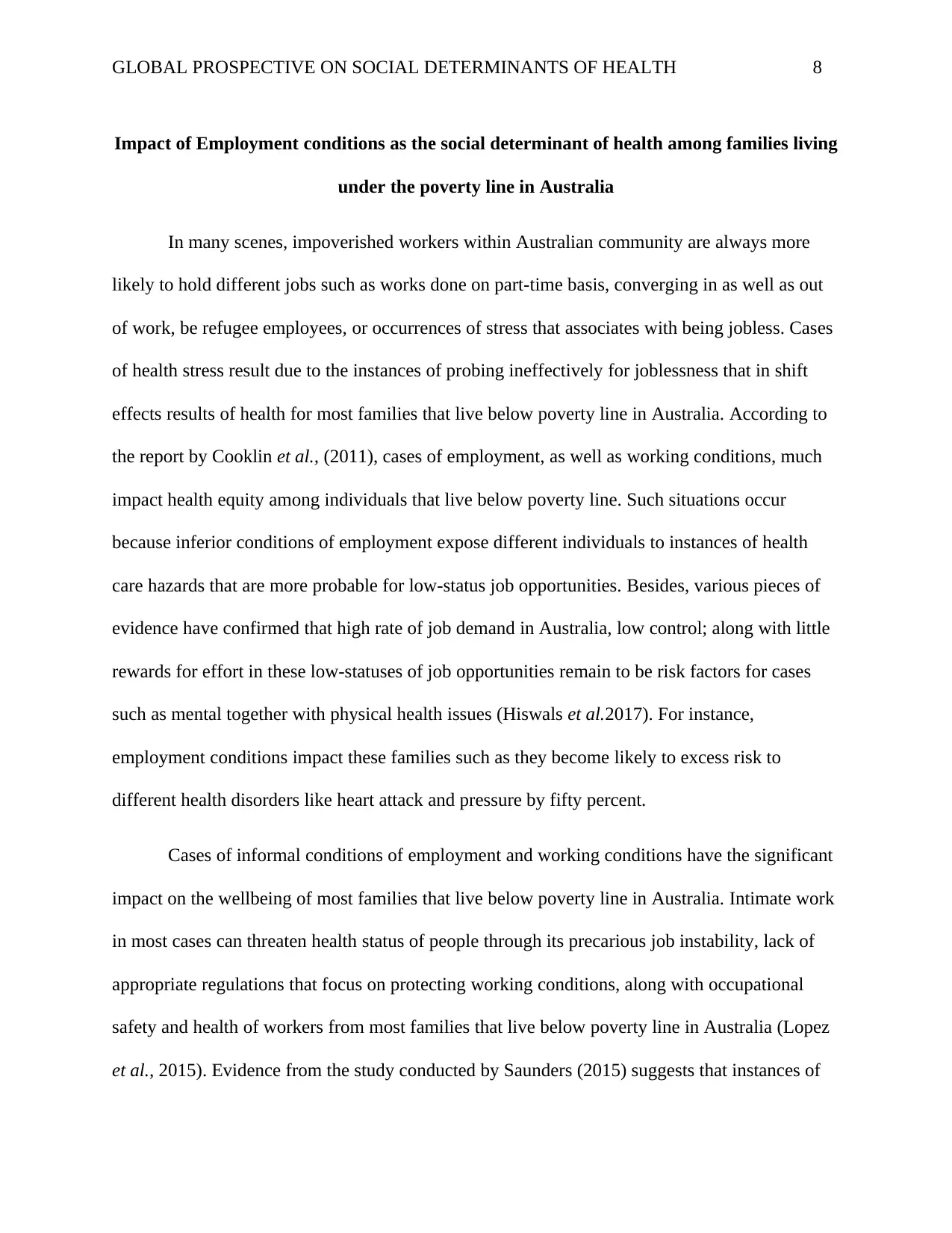
GLOBAL PROSPECTIVE ON SOCIAL DETERMINANTS OF HEALTH 8
Impact of Employment conditions as the social determinant of health among families living
under the poverty line in Australia
In many scenes, impoverished workers within Australian community are always more
likely to hold different jobs such as works done on part-time basis, converging in as well as out
of work, be refugee employees, or occurrences of stress that associates with being jobless. Cases
of health stress result due to the instances of probing ineffectively for joblessness that in shift
effects results of health for most families that live below poverty line in Australia. According to
the report by Cooklin et al., (2011), cases of employment, as well as working conditions, much
impact health equity among individuals that live below poverty line. Such situations occur
because inferior conditions of employment expose different individuals to instances of health
care hazards that are more probable for low-status job opportunities. Besides, various pieces of
evidence have confirmed that high rate of job demand in Australia, low control; along with little
rewards for effort in these low-statuses of job opportunities remain to be risk factors for cases
such as mental together with physical health issues (Hiswals et al.2017). For instance,
employment conditions impact these families such as they become likely to excess risk to
different health disorders like heart attack and pressure by fifty percent.
Cases of informal conditions of employment and working conditions have the significant
impact on the wellbeing of most families that live below poverty line in Australia. Intimate work
in most cases can threaten health status of people through its precarious job instability, lack of
appropriate regulations that focus on protecting working conditions, along with occupational
safety and health of workers from most families that live below poverty line in Australia (Lopez
et al., 2015). Evidence from the study conducted by Saunders (2015) suggests that instances of
Impact of Employment conditions as the social determinant of health among families living
under the poverty line in Australia
In many scenes, impoverished workers within Australian community are always more
likely to hold different jobs such as works done on part-time basis, converging in as well as out
of work, be refugee employees, or occurrences of stress that associates with being jobless. Cases
of health stress result due to the instances of probing ineffectively for joblessness that in shift
effects results of health for most families that live below poverty line in Australia. According to
the report by Cooklin et al., (2011), cases of employment, as well as working conditions, much
impact health equity among individuals that live below poverty line. Such situations occur
because inferior conditions of employment expose different individuals to instances of health
care hazards that are more probable for low-status job opportunities. Besides, various pieces of
evidence have confirmed that high rate of job demand in Australia, low control; along with little
rewards for effort in these low-statuses of job opportunities remain to be risk factors for cases
such as mental together with physical health issues (Hiswals et al.2017). For instance,
employment conditions impact these families such as they become likely to excess risk to
different health disorders like heart attack and pressure by fifty percent.
Cases of informal conditions of employment and working conditions have the significant
impact on the wellbeing of most families that live below poverty line in Australia. Intimate work
in most cases can threaten health status of people through its precarious job instability, lack of
appropriate regulations that focus on protecting working conditions, along with occupational
safety and health of workers from most families that live below poverty line in Australia (Lopez
et al., 2015). Evidence from the study conducted by Saunders (2015) suggests that instances of
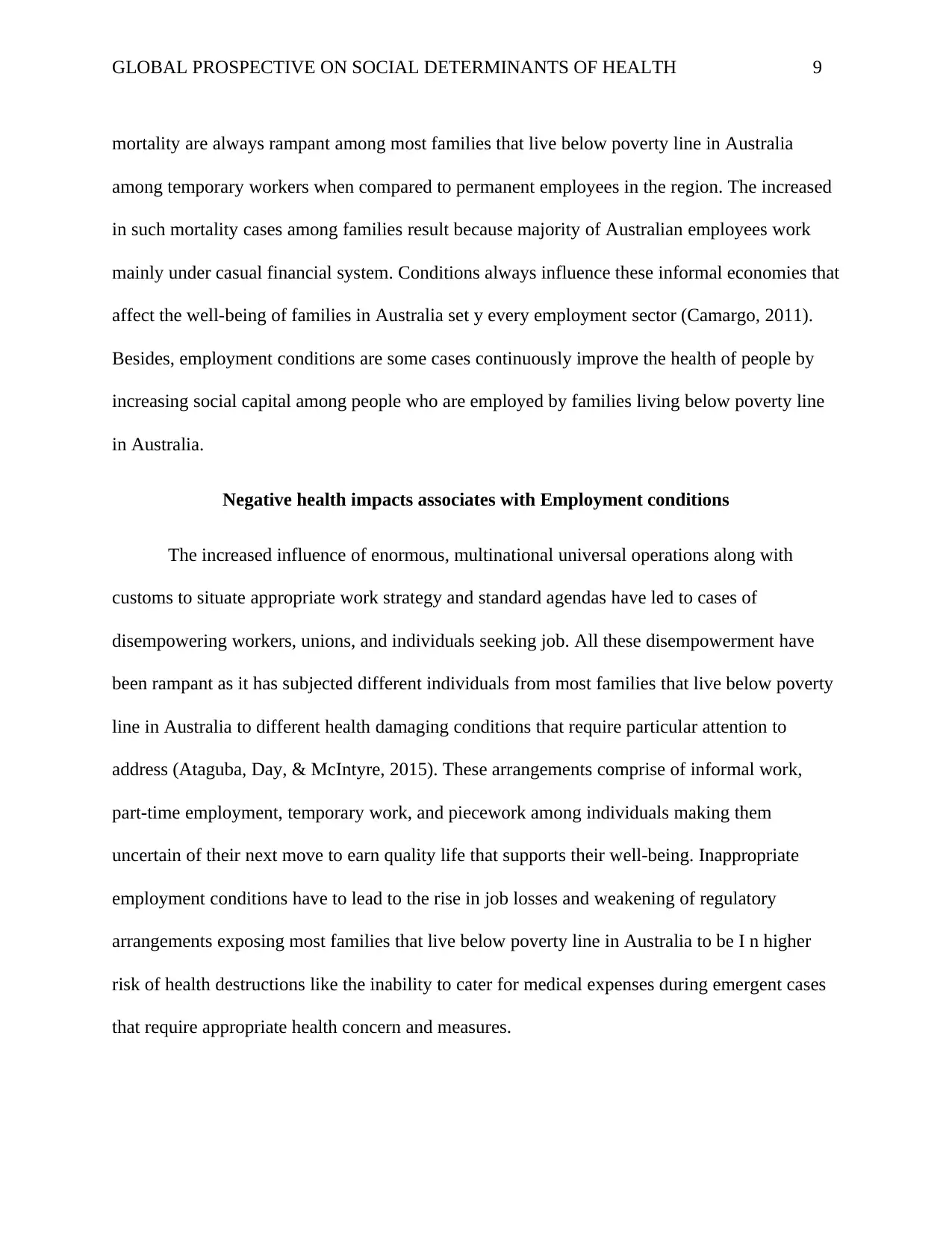
GLOBAL PROSPECTIVE ON SOCIAL DETERMINANTS OF HEALTH 9
mortality are always rampant among most families that live below poverty line in Australia
among temporary workers when compared to permanent employees in the region. The increased
in such mortality cases among families result because majority of Australian employees work
mainly under casual financial system. Conditions always influence these informal economies that
affect the well-being of families in Australia set y every employment sector (Camargo, 2011).
Besides, employment conditions are some cases continuously improve the health of people by
increasing social capital among people who are employed by families living below poverty line
in Australia.
Negative health impacts associates with Employment conditions
The increased influence of enormous, multinational universal operations along with
customs to situate appropriate work strategy and standard agendas have led to cases of
disempowering workers, unions, and individuals seeking job. All these disempowerment have
been rampant as it has subjected different individuals from most families that live below poverty
line in Australia to different health damaging conditions that require particular attention to
address (Ataguba, Day, & McIntyre, 2015). These arrangements comprise of informal work,
part-time employment, temporary work, and piecework among individuals making them
uncertain of their next move to earn quality life that supports their well-being. Inappropriate
employment conditions have to lead to the rise in job losses and weakening of regulatory
arrangements exposing most families that live below poverty line in Australia to be I n higher
risk of health destructions like the inability to cater for medical expenses during emergent cases
that require appropriate health concern and measures.
mortality are always rampant among most families that live below poverty line in Australia
among temporary workers when compared to permanent employees in the region. The increased
in such mortality cases among families result because majority of Australian employees work
mainly under casual financial system. Conditions always influence these informal economies that
affect the well-being of families in Australia set y every employment sector (Camargo, 2011).
Besides, employment conditions are some cases continuously improve the health of people by
increasing social capital among people who are employed by families living below poverty line
in Australia.
Negative health impacts associates with Employment conditions
The increased influence of enormous, multinational universal operations along with
customs to situate appropriate work strategy and standard agendas have led to cases of
disempowering workers, unions, and individuals seeking job. All these disempowerment have
been rampant as it has subjected different individuals from most families that live below poverty
line in Australia to different health damaging conditions that require particular attention to
address (Ataguba, Day, & McIntyre, 2015). These arrangements comprise of informal work,
part-time employment, temporary work, and piecework among individuals making them
uncertain of their next move to earn quality life that supports their well-being. Inappropriate
employment conditions have to lead to the rise in job losses and weakening of regulatory
arrangements exposing most families that live below poverty line in Australia to be I n higher
risk of health destructions like the inability to cater for medical expenses during emergent cases
that require appropriate health concern and measures.
⊘ This is a preview!⊘
Do you want full access?
Subscribe today to unlock all pages.

Trusted by 1+ million students worldwide
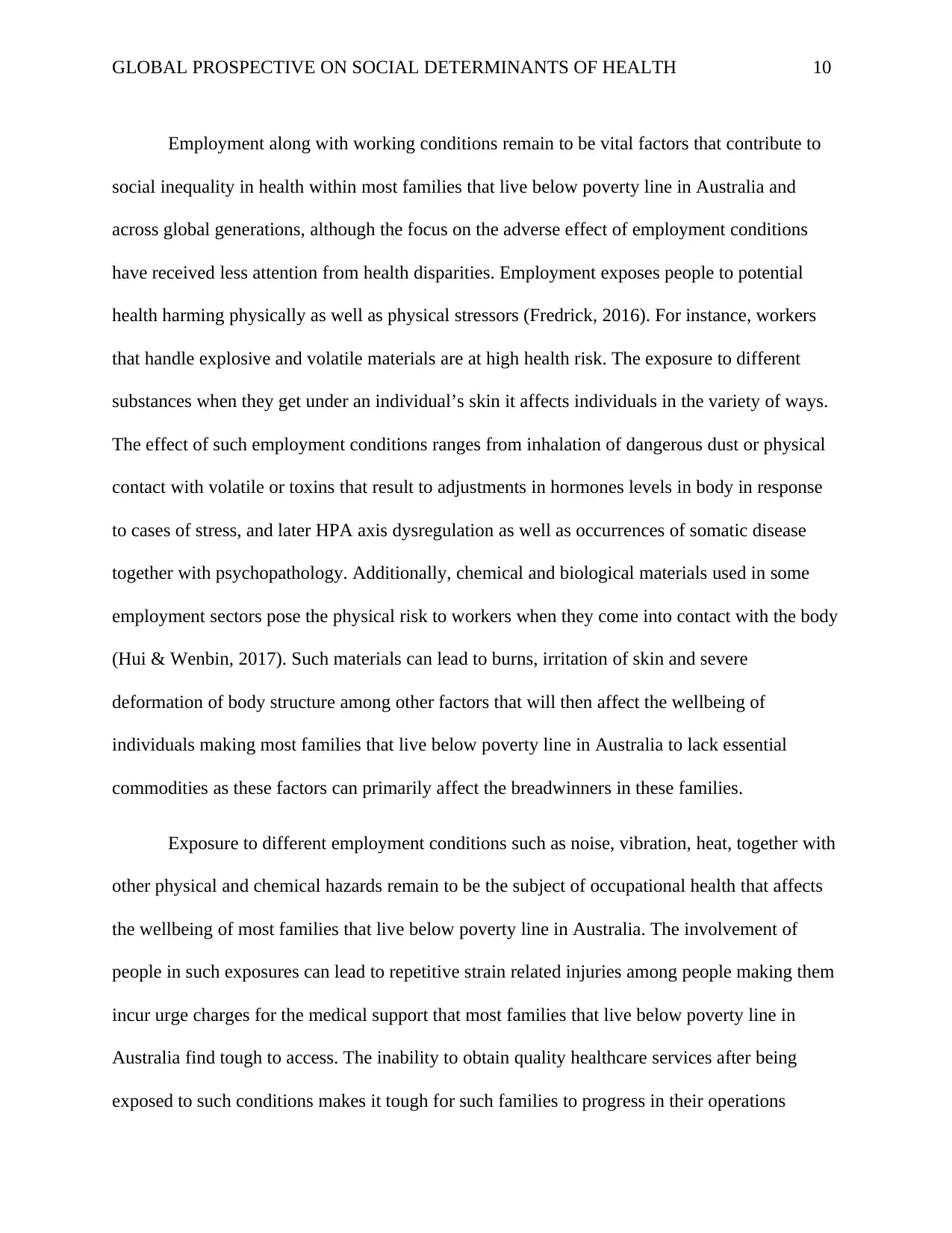
GLOBAL PROSPECTIVE ON SOCIAL DETERMINANTS OF HEALTH 10
Employment along with working conditions remain to be vital factors that contribute to
social inequality in health within most families that live below poverty line in Australia and
across global generations, although the focus on the adverse effect of employment conditions
have received less attention from health disparities. Employment exposes people to potential
health harming physically as well as physical stressors (Fredrick, 2016). For instance, workers
that handle explosive and volatile materials are at high health risk. The exposure to different
substances when they get under an individual’s skin it affects individuals in the variety of ways.
The effect of such employment conditions ranges from inhalation of dangerous dust or physical
contact with volatile or toxins that result to adjustments in hormones levels in body in response
to cases of stress, and later HPA axis dysregulation as well as occurrences of somatic disease
together with psychopathology. Additionally, chemical and biological materials used in some
employment sectors pose the physical risk to workers when they come into contact with the body
(Hui & Wenbin, 2017). Such materials can lead to burns, irritation of skin and severe
deformation of body structure among other factors that will then affect the wellbeing of
individuals making most families that live below poverty line in Australia to lack essential
commodities as these factors can primarily affect the breadwinners in these families.
Exposure to different employment conditions such as noise, vibration, heat, together with
other physical and chemical hazards remain to be the subject of occupational health that affects
the wellbeing of most families that live below poverty line in Australia. The involvement of
people in such exposures can lead to repetitive strain related injuries among people making them
incur urge charges for the medical support that most families that live below poverty line in
Australia find tough to access. The inability to obtain quality healthcare services after being
exposed to such conditions makes it tough for such families to progress in their operations
Employment along with working conditions remain to be vital factors that contribute to
social inequality in health within most families that live below poverty line in Australia and
across global generations, although the focus on the adverse effect of employment conditions
have received less attention from health disparities. Employment exposes people to potential
health harming physically as well as physical stressors (Fredrick, 2016). For instance, workers
that handle explosive and volatile materials are at high health risk. The exposure to different
substances when they get under an individual’s skin it affects individuals in the variety of ways.
The effect of such employment conditions ranges from inhalation of dangerous dust or physical
contact with volatile or toxins that result to adjustments in hormones levels in body in response
to cases of stress, and later HPA axis dysregulation as well as occurrences of somatic disease
together with psychopathology. Additionally, chemical and biological materials used in some
employment sectors pose the physical risk to workers when they come into contact with the body
(Hui & Wenbin, 2017). Such materials can lead to burns, irritation of skin and severe
deformation of body structure among other factors that will then affect the wellbeing of
individuals making most families that live below poverty line in Australia to lack essential
commodities as these factors can primarily affect the breadwinners in these families.
Exposure to different employment conditions such as noise, vibration, heat, together with
other physical and chemical hazards remain to be the subject of occupational health that affects
the wellbeing of most families that live below poverty line in Australia. The involvement of
people in such exposures can lead to repetitive strain related injuries among people making them
incur urge charges for the medical support that most families that live below poverty line in
Australia find tough to access. The inability to obtain quality healthcare services after being
exposed to such conditions makes it tough for such families to progress in their operations
Paraphrase This Document
Need a fresh take? Get an instant paraphrase of this document with our AI Paraphraser
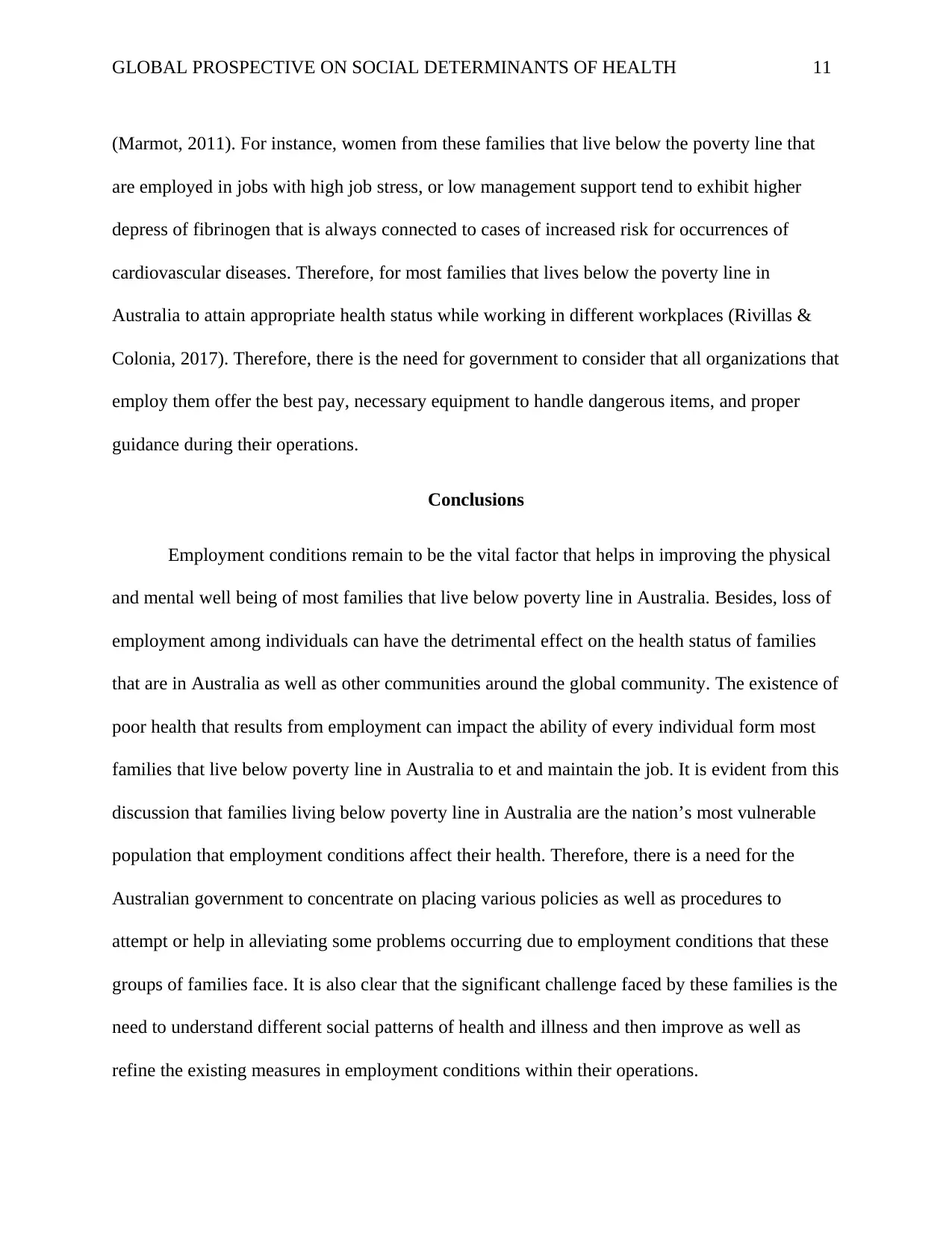
GLOBAL PROSPECTIVE ON SOCIAL DETERMINANTS OF HEALTH 11
(Marmot, 2011). For instance, women from these families that live below the poverty line that
are employed in jobs with high job stress, or low management support tend to exhibit higher
depress of fibrinogen that is always connected to cases of increased risk for occurrences of
cardiovascular diseases. Therefore, for most families that lives below the poverty line in
Australia to attain appropriate health status while working in different workplaces (Rivillas &
Colonia, 2017). Therefore, there is the need for government to consider that all organizations that
employ them offer the best pay, necessary equipment to handle dangerous items, and proper
guidance during their operations.
Conclusions
Employment conditions remain to be the vital factor that helps in improving the physical
and mental well being of most families that live below poverty line in Australia. Besides, loss of
employment among individuals can have the detrimental effect on the health status of families
that are in Australia as well as other communities around the global community. The existence of
poor health that results from employment can impact the ability of every individual form most
families that live below poverty line in Australia to et and maintain the job. It is evident from this
discussion that families living below poverty line in Australia are the nation’s most vulnerable
population that employment conditions affect their health. Therefore, there is a need for the
Australian government to concentrate on placing various policies as well as procedures to
attempt or help in alleviating some problems occurring due to employment conditions that these
groups of families face. It is also clear that the significant challenge faced by these families is the
need to understand different social patterns of health and illness and then improve as well as
refine the existing measures in employment conditions within their operations.
(Marmot, 2011). For instance, women from these families that live below the poverty line that
are employed in jobs with high job stress, or low management support tend to exhibit higher
depress of fibrinogen that is always connected to cases of increased risk for occurrences of
cardiovascular diseases. Therefore, for most families that lives below the poverty line in
Australia to attain appropriate health status while working in different workplaces (Rivillas &
Colonia, 2017). Therefore, there is the need for government to consider that all organizations that
employ them offer the best pay, necessary equipment to handle dangerous items, and proper
guidance during their operations.
Conclusions
Employment conditions remain to be the vital factor that helps in improving the physical
and mental well being of most families that live below poverty line in Australia. Besides, loss of
employment among individuals can have the detrimental effect on the health status of families
that are in Australia as well as other communities around the global community. The existence of
poor health that results from employment can impact the ability of every individual form most
families that live below poverty line in Australia to et and maintain the job. It is evident from this
discussion that families living below poverty line in Australia are the nation’s most vulnerable
population that employment conditions affect their health. Therefore, there is a need for the
Australian government to concentrate on placing various policies as well as procedures to
attempt or help in alleviating some problems occurring due to employment conditions that these
groups of families face. It is also clear that the significant challenge faced by these families is the
need to understand different social patterns of health and illness and then improve as well as
refine the existing measures in employment conditions within their operations.
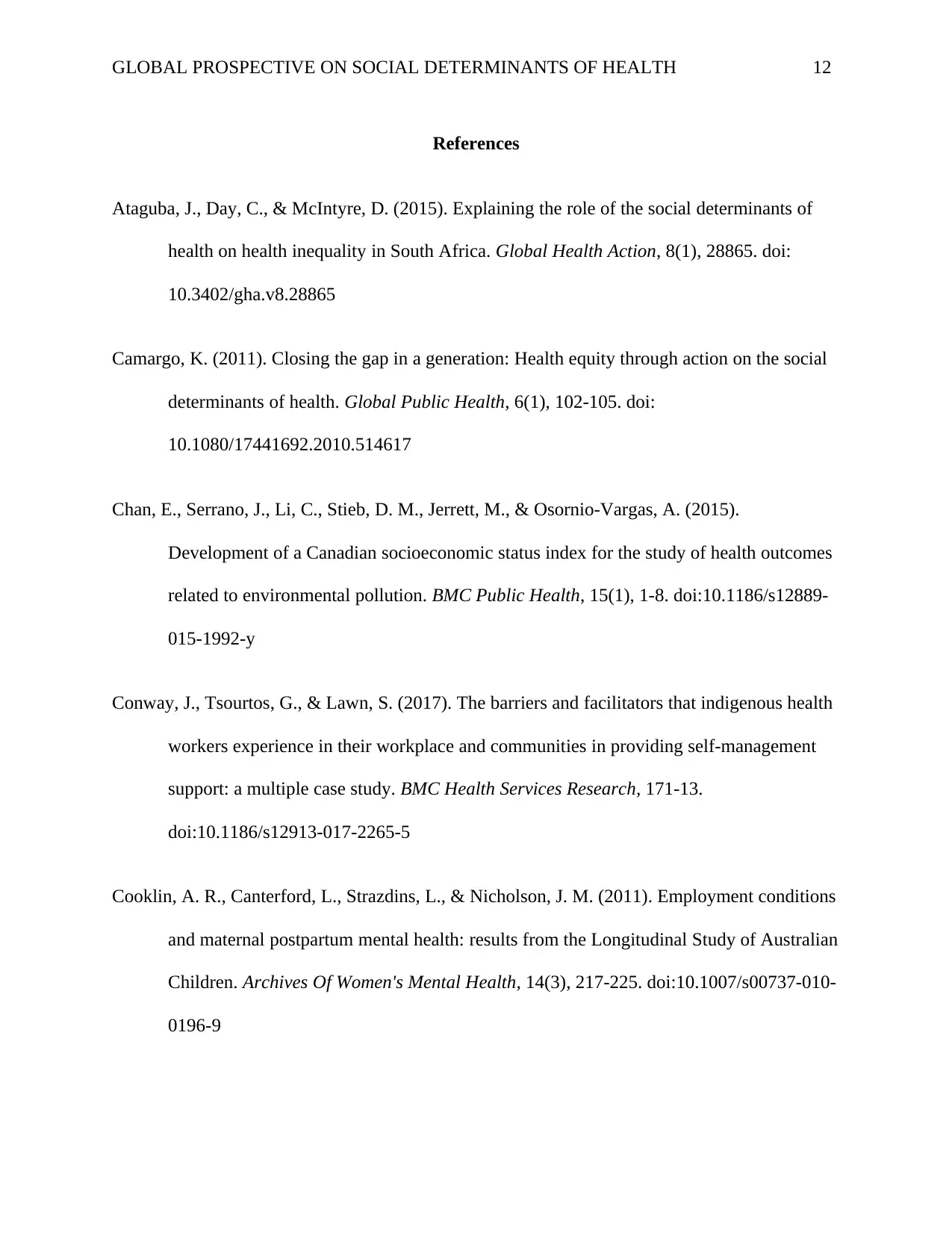
GLOBAL PROSPECTIVE ON SOCIAL DETERMINANTS OF HEALTH 12
References
Ataguba, J., Day, C., & McIntyre, D. (2015). Explaining the role of the social determinants of
health on health inequality in South Africa. Global Health Action, 8(1), 28865. doi:
10.3402/gha.v8.28865
Camargo, K. (2011). Closing the gap in a generation: Health equity through action on the social
determinants of health. Global Public Health, 6(1), 102-105. doi:
10.1080/17441692.2010.514617
Chan, E., Serrano, J., Li, C., Stieb, D. M., Jerrett, M., & Osornio-Vargas, A. (2015).
Development of a Canadian socioeconomic status index for the study of health outcomes
related to environmental pollution. BMC Public Health, 15(1), 1-8. doi:10.1186/s12889-
015-1992-y
Conway, J., Tsourtos, G., & Lawn, S. (2017). The barriers and facilitators that indigenous health
workers experience in their workplace and communities in providing self-management
support: a multiple case study. BMC Health Services Research, 171-13.
doi:10.1186/s12913-017-2265-5
Cooklin, A. R., Canterford, L., Strazdins, L., & Nicholson, J. M. (2011). Employment conditions
and maternal postpartum mental health: results from the Longitudinal Study of Australian
Children. Archives Of Women's Mental Health, 14(3), 217-225. doi:10.1007/s00737-010-
0196-9
References
Ataguba, J., Day, C., & McIntyre, D. (2015). Explaining the role of the social determinants of
health on health inequality in South Africa. Global Health Action, 8(1), 28865. doi:
10.3402/gha.v8.28865
Camargo, K. (2011). Closing the gap in a generation: Health equity through action on the social
determinants of health. Global Public Health, 6(1), 102-105. doi:
10.1080/17441692.2010.514617
Chan, E., Serrano, J., Li, C., Stieb, D. M., Jerrett, M., & Osornio-Vargas, A. (2015).
Development of a Canadian socioeconomic status index for the study of health outcomes
related to environmental pollution. BMC Public Health, 15(1), 1-8. doi:10.1186/s12889-
015-1992-y
Conway, J., Tsourtos, G., & Lawn, S. (2017). The barriers and facilitators that indigenous health
workers experience in their workplace and communities in providing self-management
support: a multiple case study. BMC Health Services Research, 171-13.
doi:10.1186/s12913-017-2265-5
Cooklin, A. R., Canterford, L., Strazdins, L., & Nicholson, J. M. (2011). Employment conditions
and maternal postpartum mental health: results from the Longitudinal Study of Australian
Children. Archives Of Women's Mental Health, 14(3), 217-225. doi:10.1007/s00737-010-
0196-9
⊘ This is a preview!⊘
Do you want full access?
Subscribe today to unlock all pages.

Trusted by 1+ million students worldwide
1 out of 15
Related Documents
Your All-in-One AI-Powered Toolkit for Academic Success.
+13062052269
info@desklib.com
Available 24*7 on WhatsApp / Email
![[object Object]](/_next/static/media/star-bottom.7253800d.svg)
Unlock your academic potential
Copyright © 2020–2025 A2Z Services. All Rights Reserved. Developed and managed by ZUCOL.





